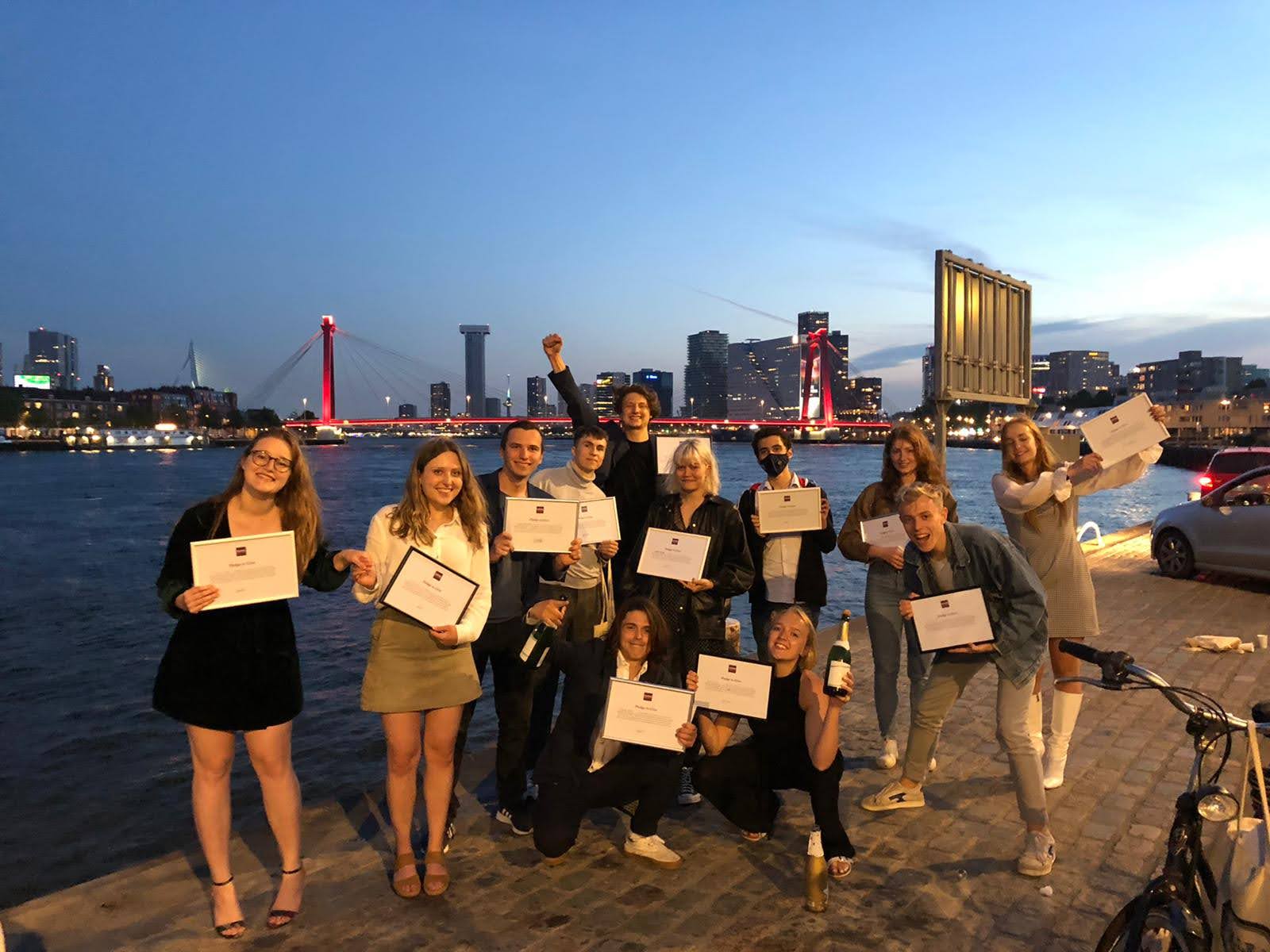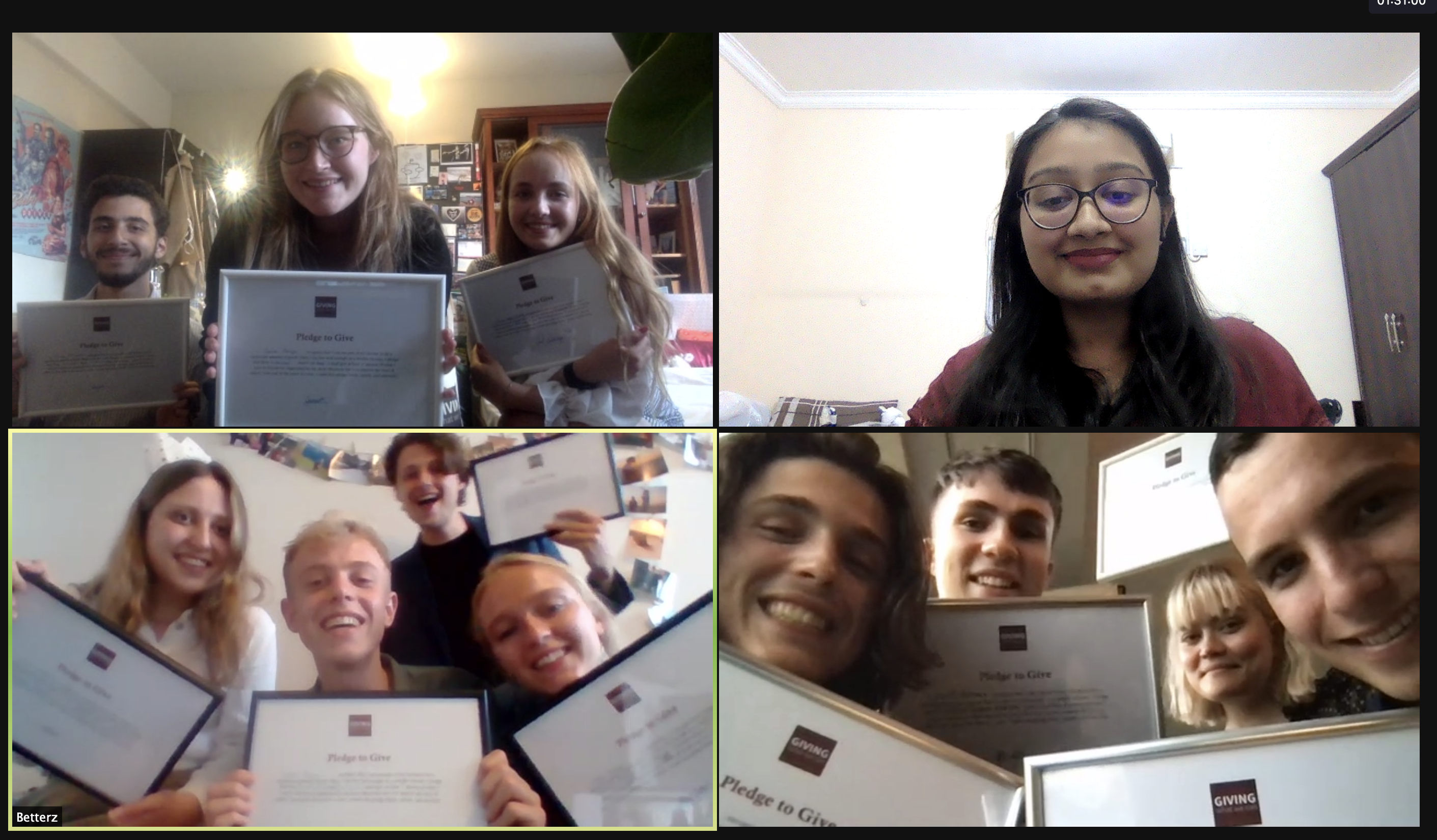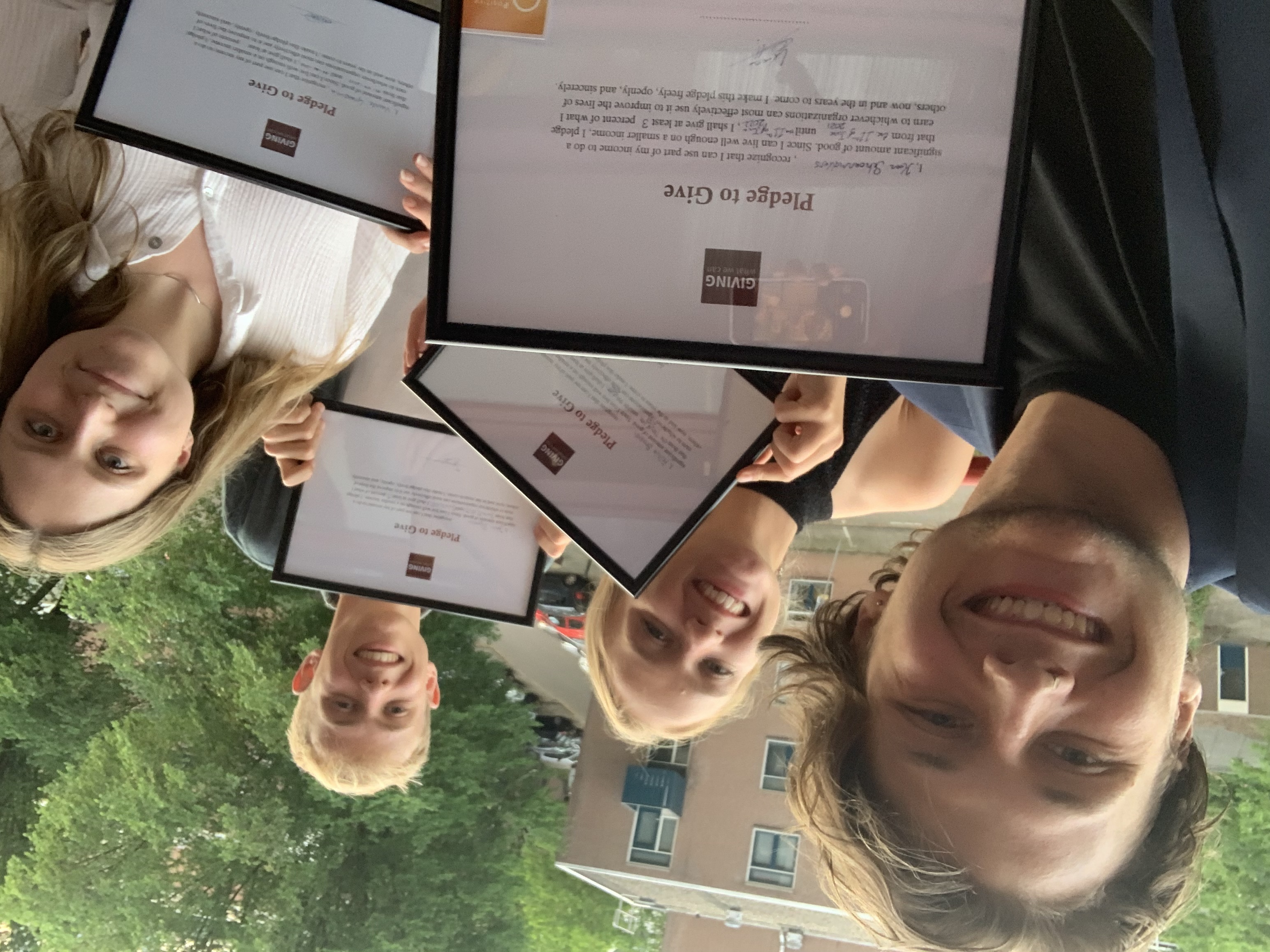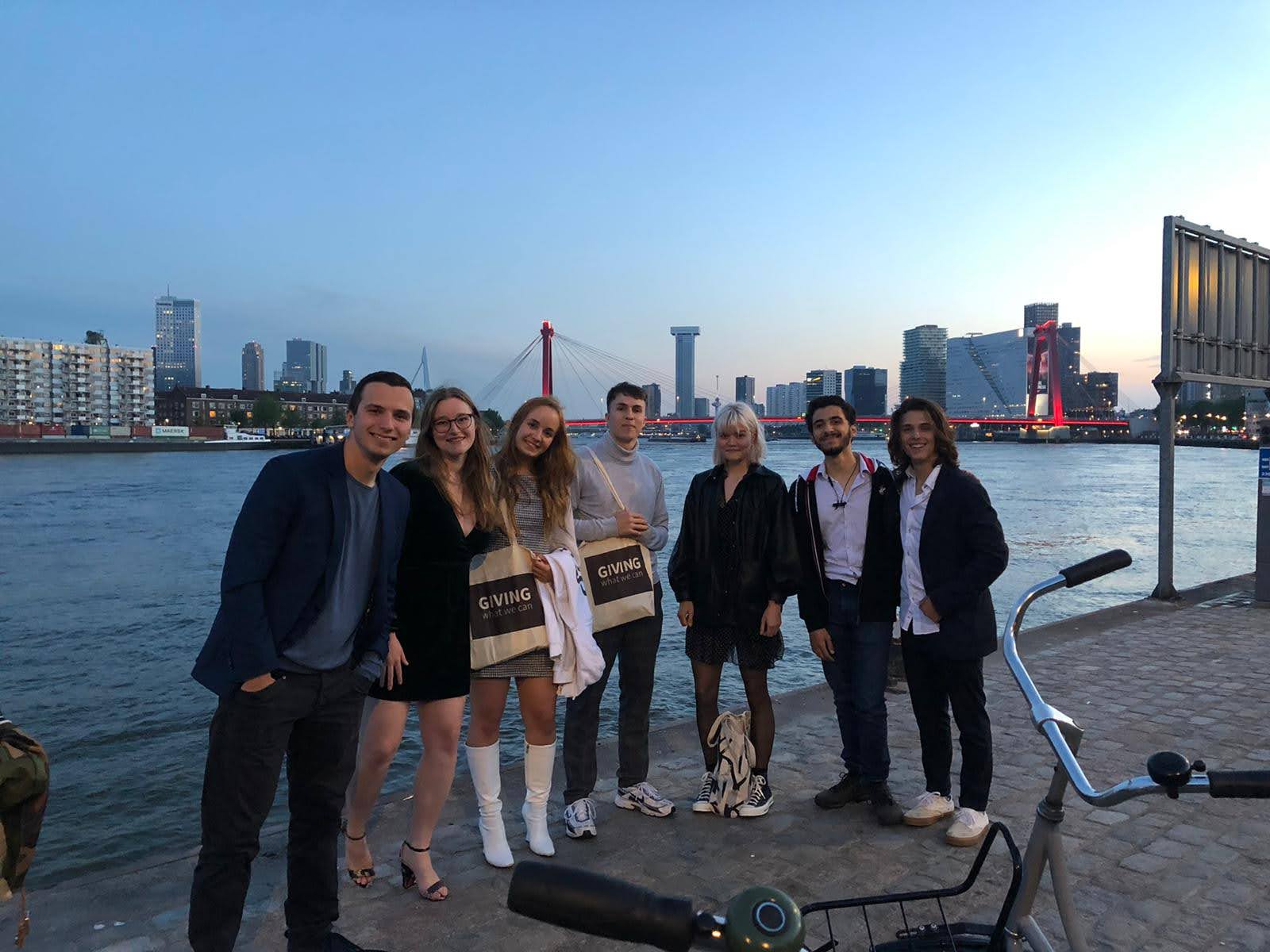In June 2021, the Positive Impact Society Erasmus (PISE) hosted a pledge party at which 13 of our members celebrated taking The Giving What We Can Pledge or Try Giving Pledge for the first time. As we are a student group with a very small budget, Giving What We Can generously sponsored the event.
The pledge party was well-received by our members and we are now hoping to make it an annual tradition. We believe that this type of event is worth running at other effective altruism groups. Celebrating the pledge with members of your community can create more emotional and longer-lasting memories than, for example, signing the pledge alone on a random day. There were several components involved in making this event a success: personal contact between organisers and potential pledgers, informed decision making, and creating an intimate, celebratory atmosphere. We hope that creating cherished memories out of pledging will result in stronger commitments to fulfilling the pledge in the long term.
Informed Decision Making
We wanted to focus on having people pledge based on a very conscious, informed decision. Thus, we first contacted all of our active members via phone and had short discussions about the possible pledges to gain their interest. After that, we organised an informational evening with Jo Duyvestyn (who took The Pledge in 2014). During this informational event, she told us about her personal experience and offered some general information on pledging. We believe that this was quite helpful for people who were uncertain about making a commitment. They were able to ask questions, voice concerns, and connect on a personal level with someone who’s been a long-time pledger. We followed up on the informational session with another round of individual messages to see if our members were still interested in pledging.
Personal Contact with Potential Pledgers
Continued personal contact with our potential pledgers was an important aspect of our program. As a team of five, each of us was responsible for staying in touch with a handful of members. We made ourselves available to answer their questions. This approach was chosen to create an atmosphere of comfort in asking intimate questions and airing any doubts about pledging. With this method, we were able to address and advise based on individual circumstances. As we are a student group, our target audience was students — therefore, not everyone was financially stable. For example, one of our members works two student jobs to support themselves. We advised them to wait until they have the financial means to pledge. Another member was just finishing up their master’s degree, so we advised them to pledge soon after they started working. During the process of communication, we learnt that it is very important to understand that members can feel peer-pressured. Therefore, it is essential to make sure they are comfortable with pledging. Pledging to donate a significant amount of your income is a big decision, and by accommodating personal circumstances we believe we were able to help alleviate some of the doubts and concerns surrounding our members’ personal circumstances.
An Intimate, Celebratory Event
We are quite charmed by the idea of combining altruism with celebration. Some of our members are inspired by George Rosenfeld, who is a vocal proponent of this idea. Therefore, we knew from the start that we wanted to organise a very special event that recognised everyone’s contributions and instilled the feeling of a community within the pledgers. Our final event was a semi-formal dinner and pledging program. Due to the Covid-19 restrictions in place at the time, we were only allowed to gather in groups of four people indoors. So we split our pledgers into three groups with the option to participate online for those still abroad. We organised an evening program with food, games, a ceremonious signing of the pledge certificate, and a photoshoot. One game that was highly appreciated was the speech competition; the three groups were asked to prepare a short speech about the value of effective giving “aiming at the visionary level of Martin Luther King Jr.‘s ‘I Have A Dream’ speech and the celebratory atmosphere of Barack Obama’s 2008 election victory speech…but prepared in five minutes.” This was a great success: it led to some hilarious improvised speeches, but also to some real heartfelt moments which helped people remember why they were pledging. We also gave out gift bags with the framed certificate, a small plant, and stickers. The gifts were placed in tote bags with the GWWC logo on it, and all participants had the opportunity to sign each other’s bags to remember the celebration.
At the end of the event, we all gathered outdoors to take a group picture and pop champagne. We not only organised a successful event, but we also brought together a group of dedicated do-gooders. One important thing we learnt during the process of organising was that it is very important to keep a constant connection and to follow up with the pledgers. To that end, we sent a printed group picture to all the pledgers as a little surprise in their post box.

Covid-19
Initially, our aim was to organise a gala celebration to thank all pledgers and to grow awareness about this way of incorporating doing good into our daily life. However, due to the risks and restrictions, we had to manage in small groups which we found equally fun. In our eyes, our intimate celebratory event was a huge success.

Focus on Already-Aligned Individuals
Out of the 37 people we initially contacted about the event, 13 people (slightly more than a third) attended. As we went through each stage of calls and information sharing, we noticed that the people who stayed interested and engaged were those who showed a high degree of interest from the start. This suggests to us that the people who will be most likely to participate in such an event are the ones already thinking about pledging. It may be that a small number of people who were initially unfamiliar with, or uninterested in, the pledge can be convinced through information and social exposure to take the pledge. Even if they weren’t convinced to take the pledge this year, it’s possible that our event “planted a seed” for the future. In that case, we may be growing our pool of aligned individuals, and able to attract more people who would like to pledge with us at future events.

Organise Your Own Pledge Party!
We highly recommend organising your own pledge party to celebrate your pledgers and build a community of do-gooders. Such events provide opportunities for people to explore, learn, and appreciate one another as it instills a sense of community. We would like to sincerely thank Luke Freeman, who was of great help to us and was open to all of our questions and concerns. He helped us be more confident in our planning and was always there to guide us when needed. We would advise all pledge party hosts to contact him! We hope this piece helps you and we are always available to help out as well. Contact us at: board@piserotterdam.com.

This was great work by the PISE team! We are hoping to help groups to organise lots of pledge parties this coming January to welcome in new members from 2021 (and January 1 is our most popular pledge date). Please get in touch with me if you’d like to organise one for your group and want some help!
Congratulations on the great success PISE!
It’s amazing to see how many pledges you’ve accomplished and spoken from the EA Rotterdam (city) group, I think most/all of these are counterfactual pledges that would otherwise not have happened.